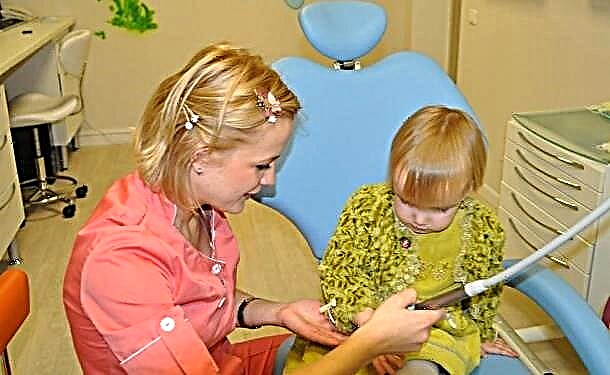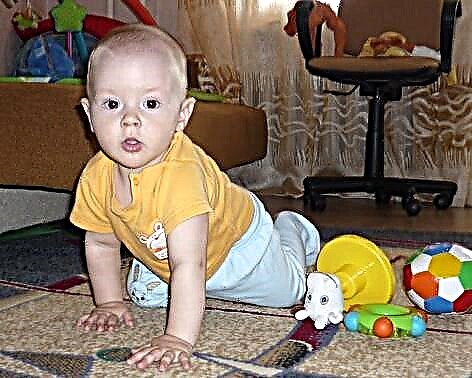
A child's body is not at all structured like that of adults. Quite often, parents notice that their baby is breathing not through the nose, but through the mouth. This is the norm or pathology, this article will help you figure it out.

Causes of mouth breathing in babies
Normally, a person breathes through his nose. The oropharynx can also participate in respiration, but this is not a very physiological process. This is how an adult organism works. For a child, things may be somewhat different, especially for very young babies.
Nasal breathing is essential. The air in the environment is slightly lower in temperature than the body requires. Passing through the whole system of the nasal passages, it warms up well and is additionally moisturized.

The mucous membranes of the nose are lined with epithelial cells, on the outer surface of which there are quite a few small cilia. These formations trap the smallest dust particles, preventing the body from entering the internal environment.
If the baby breathes through the mouth, then the air does not have time to fully warm up and immediately enters the lower respiratory tract. This situation contributes to the development of various diseases of the ENT organs in the child. Babies who often breathe with their mouths are more likely to get pharyngitis and laryngitis, and also have a rather high risk of getting bronchitis.

The appearance of such a symptom in a child over two years old should be a signal for parents that the baby may have some pathologies leading to the development of this symptom.
Observant dads and mothers decide to show the baby to the doctor. In this case, they are right. Many diseases occur in children without the manifestation of multiple clinical signs. Breathing through the mouth can be the first "bell" that the child's body needs help.
If the baby begins to breathe through his mouth on the street, then the risk of infection with various infections, as well as colds, increases many times over. According to statistics, children living in large industrial cities are more likely to get sick with various pathologies of the respiratory tract. Freezing air into the lungs can contribute to the onset of the inflammatory process with the development of pneumonia.

It is imperative to take into account the age of the child at which the parents noticed that the baby is used to constantly breathing through the mouth.
If a baby over 3 years old is constantly breathing through the mouth, then this may indicate that he has signs of any diseases of the paranasal sinuses. This symptom can manifest itself in children suffering from a protracted course of chronic sinusitis or sinusitis. These diseases are also accompanied by the development of severe nasal congestion.

If a baby has this symptom when he sleeps, then parents should definitely watch him during sleep. Babies who throw their heads back strongly from the pillow often breathe through an open mouth. It is quite simple to eliminate this unfavorable symptom in this situation. You just need to pick up another pillow, the sleep on which will be as comfortable as possible for the baby.

In schoolchildren, nasal breathing disorders and breathing air through the mouth may also be manifestation of adenoids. This pathological condition is accompanied by active growth of adenoid tissue, which overgrows in the nasopharynx. It takes time for adenoids to develop. Usually, this process develops in a child over several years. Respiratory disorders in this case are of an increasing nature.

It is almost impossible to identify the manifestation of this symptom in babies at the earliest stages. Only a few years later, the child begins to actively breathe through the mouth. This symptom manifests itself in a baby both in the daytime and at night.
Unfortunately, it is very difficult to cure pronounced adenoids in the nasopharynx with only medication. In some cases, surgical methods of therapy are used.

Increased palatine tonsils - also a fairly common pathology that develops in babies. A variety of reasons can lead to the development of this pathological condition in children. Quite often, an increase in the tonsils is recorded in children who have undergone severe bacterial sore throat.
Chronic tonsillitis also promotes hypertrophy (enlargement) of the palatine tonsils. The growth of these formations leads to a mechanical narrowing of the airway lumen. This situation is dangerous not only because the baby begins to breathe with his mouth, but also because he can develop very dangerous complications.


A protracted course of this pathological condition can also contribute to the development of symptoms of respiratory failure in a child, associated with the fact that the baby has developed signs of oxygen starvation (hypoxia) of tissues.

The development of impaired breathing can lead not only to the active growth of adenoids, but also polyps. These formations can also significantly disrupt nasal breathing. The number of polyps in babies can be very different. Their active growth is observed in children with reduced immunity or concomitant diseases of ENT organs.
According to statistics, polyps growing in the nasopharynx are more common in children aged 7-12 years. Doctors note that a hereditary factor plays an important role in the development of this pathological condition.


If one of the parents had nasopharyngeal polyposis, then the risk of developing this pathology in a child increases several times. Treatment of this pathological condition, as a rule, is long-term and is selected strictly individually by a pediatric otolaryngologist for each sick baby.

Respiratory diseasescaused by various viruses are also very common pathologies leading to impaired nasal breathing.
An adenovirus infection, accompanied by the appearance of a severe cold in a sick baby, often leads to the fact that the baby begins to breathe through the mouth. Also, this unfavorable symptom can manifest itself in children who have the flu or SARS.

Allergic diseasesoccurring with the development of rhinitis (runny nose) can also cause disturbances in breathing through the nose. The severity of such manifestations has a rather distinct seasonal character.
In the spring and early summer, the incidence of respiratory allergies increases significantly. This leads to the ingress of pollen from plants or shrubs into the nasopharynx. Such manifestations are mainly observed in babies who have individual sensitivity to them.

Nose injuries also contribute to the fact that the child will not be able to fully breathe through the nose. In this case, you will notice that the baby is breathing through the mouth. Most often, such situations occur in adolescence in boys. During the infliction of traumatic injury, a very dangerous condition for breathing can occur - a break in the nasal septum. In this case, the baby begins to actively breathe through the mouth.


To eliminate this adverse manifestation in a child, surgical otolaryngological treatment is required. Babies with a damaged nasal septum are fully restored. Unfortunately, it is impossible to restore full nasal breathing without such treatment.
It should be noted that schoolchildren can also experience physiological options for breathing through the mouth. This situation is possible after or during intense physical training.
The increased load contributes to the fact that the child's body requires more oxygen. In order to quickly eliminate such a condition that has arisen, the child begins to breathe frequently and intensively through the mouth.

Why does a baby breathe with an open mouth?
Quite often, mothers note that their newborn babies breathe with their mouths. Usually this condition manifests itself most often in sleep. Babies of the first months of life sleep almost all the time. This is necessary for newborn babies for active growth and development. A newborn baby sleeps a lot, not only at night, but also during the day.
Small dust particles can damage the delicate mucous membranes of the nose and mouth. They are so delicate that they are easily damaged when exposed to any mechanical stress. The immaturity of the immune system also contributes to the fact that the baby gets infections quite easily.

In newborn babies, the causes of mouth breathing can be very diverse.
If a child sleeps in an uncomfortable position, then he has to breathe through his mouth. To parents in this case you should pay attention to the crib, in which the newborn baby spends most of the time. It should be comfortable and comfortable for the baby's sleep.

A runny nose, which is called physiological in babies, also leads to a violation of nasal breathing. It occurs in almost every newborn child.
If the baby was born a little earlier than the due date or he has some congenital anomalies in the structure of ENT organs, then the risk of developing a lingering rhinitis in a child increases significantly.

To maintain good nasal breathing, microclimate indicators are very important. Too dry air tends to dry out the mucous membranes of the nasopharynx. The optimum humidity in the children's room should not fall below 50%.
If this indicator is constantly decreasing, then in this case the use of special devices - humidifiers - is required. They help to normalize humidity to optimal values.

Newborn babies can also get sick with various colds and infectious infections. They can also get infected from their parents. Dads and mothers should definitely remember that during an acute period of acute respiratory viral infections or flu, they should, if possible limit any contact with the child.
To prevent infection, it is also very important to avoid any interactions with people with temperatures. Quite often, babies are infected from relatives who come to visit in order to see a newborn baby.

In the first days of a child's life, the muscles of the back of the neck are not yet fully developed. Some babies may even have hypotonia in these muscle groups. This is manifested by the fact that the child throws his head back a little. People say that the child "does not hold his head yet." It takes some time to stabilize the cervical spine.
Hypotonicity of the muscles of the back of the neck and upper shoulder girdle contributes to the fact that the baby begins to breathe actively through the mouth. Usually this condition goes away on its own after a few months of life. At this time, you should definitely monitor how the baby breathes.

If by the year the child retains this unfavorable symptom, then a mandatory consultation with a pediatrician is required.
What can be done?
To normalize nasal breathing in babies, it is very important to monitor how the child falls asleep. His posture should be comfortable and not bring discomfort to the baby.
The crib and pillow on which the child sleeps are of great importance. Currently, there are a huge number of different products on the market that have an orthopedic effect. Sleeping on such beds not only normalizes the baby's breathing, but also helps to stabilize the spine.


To normalize nasal breathing, it is imperative to clear the nasal passages of secretion. Also for this purpose, you can use special aspirators. You can rinse the spout with saline or pharmaceutical preparations. These funds absolutely harmlessly cleanse the nasal passages of mucus.
If the baby has a breathing disorder due to various diseases of the ENT organs, then in this case a mandatory visit to the doctor is required. The doctor will draw up the necessary treatment regimen. It usually includes vasoconstrictor nasal drops or sprays. These remedies help relieve severe swelling, which leads to better nasal breathing.

It is possible to eliminate the symptoms caused by bacterial infections only with the help of antibacterial agents. Local therapy is usually used for this.
Nasal drops are usually given for 7-10 days. If, during the prescribed treatment, the baby does not feel better, then in this case, the prescribed therapy regimen must be corrected.

Allergic diseases, leading to the baby breathing with his mouth, require a mandatory appointment in treatment antihistamines. These funds help to normalize nasal breathing, as well as relieve congestion and swelling that occurs in the nasopharynx as a result of allergic inflammation.
To eliminate adverse symptoms, both local therapy and tablet preparations are used. These medications are usually prescribed for 1-2 weeks.

Weaning a baby to breathe with his mouth is a rather laborious task. To do this, you should definitely monitor his behavior. For small children who still find it difficult to explain what such breathing can lead to, it should be turned into an entertaining game.
Many babies like certain types of animals in childhood. If a child is delighted and collects cats, then you can tell him that all kittens breathe with their nose, and not with their mouth. Usually this psychological trick works well for toddlers under 3-4 years of age.

With older children, you can already try to build a constructive dialogue. You should tell your child to breathe through the nose and not through the mouth. In the conversation, emphasize that this is how dad and mom breathe.
Teens and schoolchildren can already be told what frequent mouth breathing can lead to. This psychological method can only be used if the baby's nasal respiratory function is preserved.

For why it is dangerous for a child to sleep with an open mouth, see the next video.



